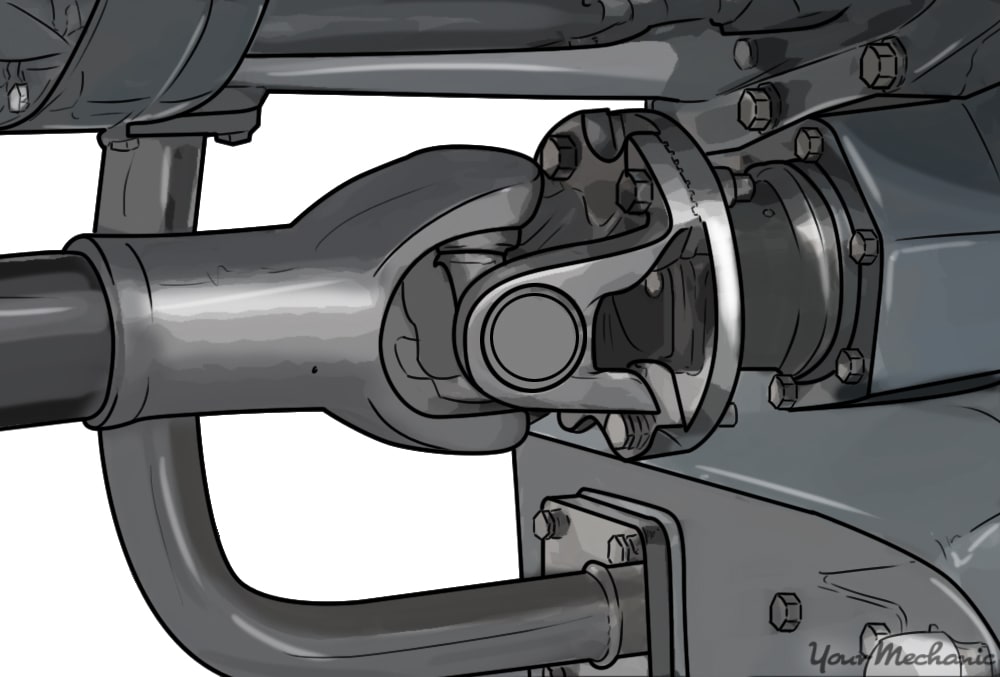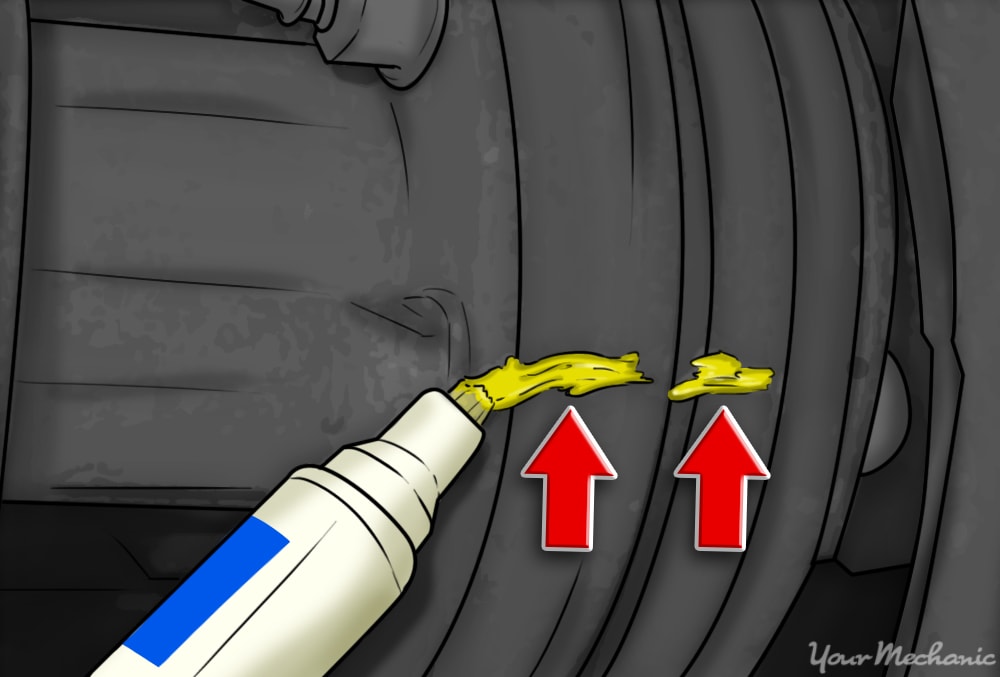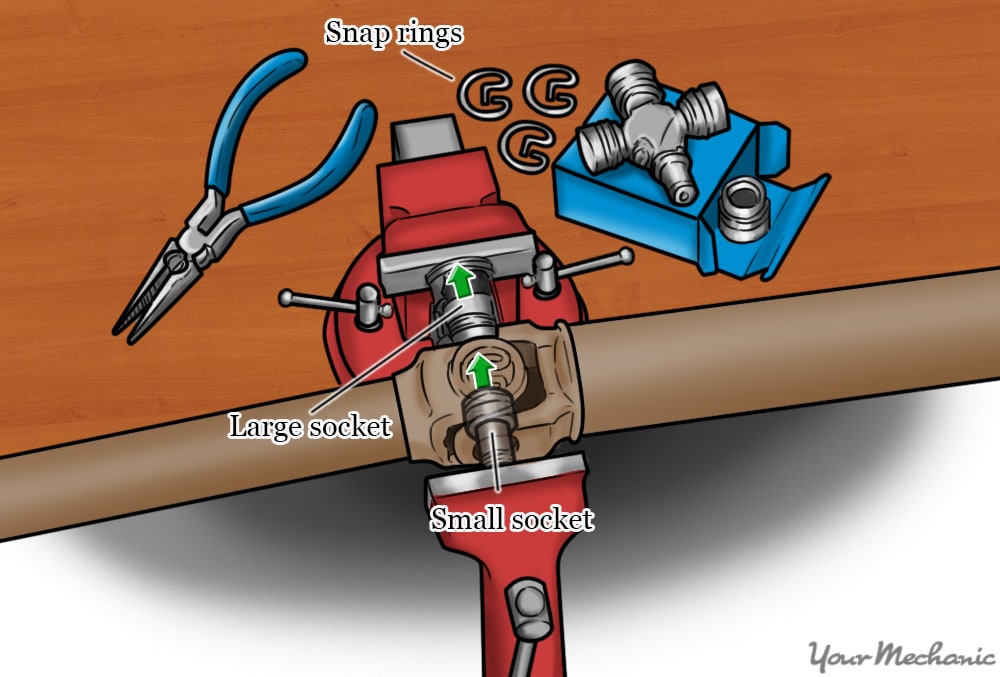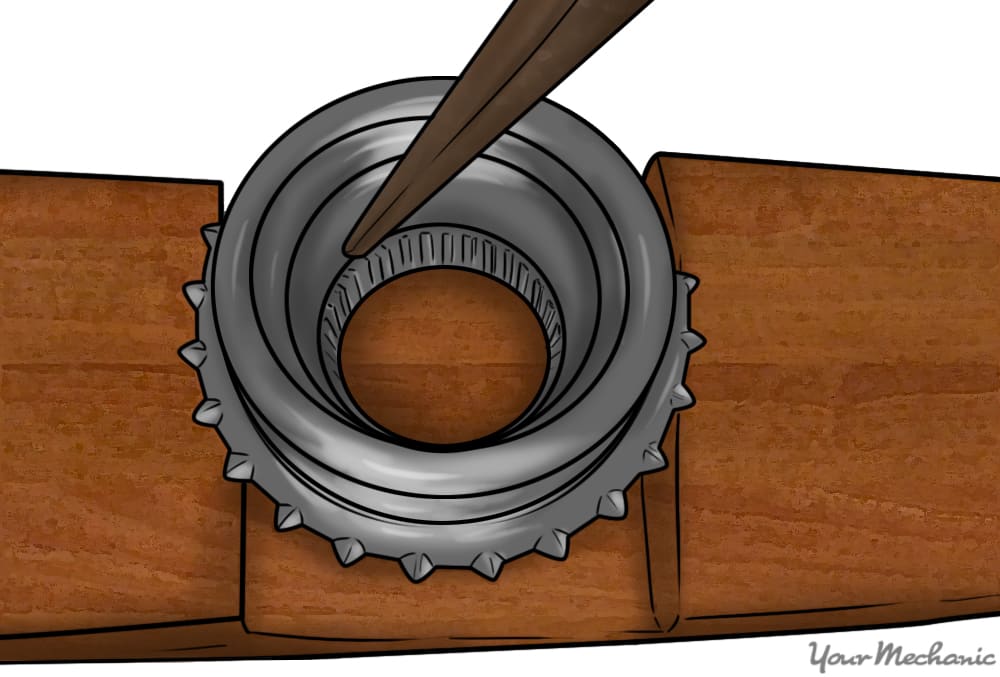

Your rear-wheel drive vehicle uses a rotating driveshaft to transfer torque (rotational force) from the transmission to the rear axle. Since the driveshaft must also be able to move up and down as the vehicle travels over bumps in the road, a universal joint at each end is fitted to provide that flexibility.
Driveshafts rotate up to three times faster than the wheels much of time and as a result u-joints can eventually wear out. Typical symptoms of u-joints that need replacing include a clunking sound when shifting gears from reverse to drive, vibration at highway speeds, and a clicking noise when moving slowly in reverse.
This article will cover the basic procedure used to inspect and replace a universal joint.
Part 1 of 5: Inspecting the u-joint
U-joints should be inspected whenever the vehicle is up on a lift to receive service such as during an oil change. Most u-joints are permanently greased and not able to be lubricated, although a few still have grease fittings. These are more likely to be found on older cars and trucks.
Step 1: Grab ahold of the driveshaft and attempt to move it. There must be no movement, since any movement indicates worn u-joints that must be replaced.
Step 2: Inspect the driveshaft. Look closely for dents, impact damage, or anything stuck to it that could cause vibration from being out-of-balance.
Part 2 of 5: Removing the driveshaft
Materials Needed
- Drain pan
- Floor jack and jack stands
- Marker
- Mechanic’s gloves
- Ratchets and sockets
- Safety glasses
- Screwdrivers
- Shop rags
Wrench set
Tip: Snap-ring pliers can also be helpful on some applications. It depends on the u-joints used in your vehicle. The job can still be accomplished if they are not available. Some vehicles use 12-point fasteners to attach the driveshaft and will require a 12-point socket or wrench.
Step 1: Jack up the vehicle. To remove the driveshaft, the rear of your vehicle will need to be jacked up with a floorjack and set securely on to jackstands.
- Warning: Never work under a vehicle being held up only by a jack. Always use jack stands.
Step 2: Mark the driveshaft. Use a felt tipped marker or whiteout to mark the driveshaft where it mates to the differential flange.
This will ensure that you can re-install it in its original position.
Step 3: Remove fasteners. There are usually 4 nuts or bolts at the rear where the driveshaft attaches to the differential.
Take these off next.
Step 4: Remove driveshaft. After removing these fasteners the driveshaft can be pushed forward, brought down and then pulled out of the transmission.
- Note: Be prepared with a pan and some rags for some transmission oil to drip out.
Part 3 of 5: Out-of-car inspection
Step 1: Check u-joints. With the driveshaft out, attempt to move each joint fully in each direction.
They must move smoothly without binding in all directions. The bearing caps are a pressed-fit in the yoke and should not move. Any roughness, binding, or wear felt during this check indicates replacement is needed since u-joints are not repairable.
Part 4 of 5: U-joint replacement
Materials Needed
- Extensions
- Hammer
- Pliers
- Ratchets and sockets
- Screwdrivers
- Shop rags
- U-joints
- Vise
- Wrench set
Step 1: Remove the old u-joint. Retainers or snap-rings are used to secure the bearing cups and these must be removed next.
It requires more force or heat being applied. However, when you install the new replacement u-joints they will come with snap rings. Three common methods are used to remove the pressed-in, u-joint bearing cups from the driveshaft.
One method requires a u-joint removal tool which is rather expensive unless you will be using it repeatedly as a professional technician.
Another method requires using a big hammer and hitting things hard. While that can be fun, you can also damage your driveshaft with a misplaced hammer swing.
The method using a vise is the one we will cover here. A vise is used to remove the u-joint by pressing the bearing cups out. A small socket is positioned over one bearing cap (use a socket just slightly smaller than the diameter of the bearing cap) and a larger socket is placed over the opposite bearing cap to receive the cap as it is pressed out of the yoke by tightening the vise.
Some needle bearings may fall out as the caps come off, but don’t worry about them since you will have new ones with your new u-joints.
Note: Snap-ring pliers will make this step easier but it can also be accomplished with a screwdriver, pliers, and a small hammer.
Note: If your driveshaft uses injected plastic to retain the bearing cups instead of snap rings, you may want to have one of YourMechanic’s technicians replace this for you.
Step 2: Install the new u-joint. Compare the new u-joint to the old one to ensure that its exactly the same size.
If grease fittings are used on the new u-joint, position it where the fitting will be accessible with a grease gun. Clean the driveshaft yoke thoroughly and inspect it for burrs or any other damage. Remove caps from new u-joint and put it in the yoke.
Use the vise and sockets to press the new caps into place in the yoke.
- Note: Take care that the needle bearings don’t fall out
Step 3: Install the snap-rings. Check for free movement and install the snap-rings.
If the new u-joint feels tight, a few taps with a hammer will usually free it up.
-
Warning: It’s ok to hit the caps and the yoke, but do not hit the driveshaft tube itself.
Part 5 of 5: Re-installing the driveshaft
Material Needed
- Shop rags
Step 1: Wipe the ends of the driveshaft clean. Make sure the driveshaft is clean by wiping it with a rag.
Step 2: Reinstall it into transmission. Lift rear of driveshaft into position and align marks made during removal.
Install the hardware and tighten securely.
Step 3: Check the transmission fluid. After the vehicle is back down on level ground, remember to check the transmission fluid if any was lost with the driveshaft removed.
Performing a repair on your vehicle can be satisfying work, especially when it’s a job where you can actually feel and hear the difference. Although rust, high mileage, and poorly maintained vehicles sometimes add to the challenge, replacing u-joints is certainly within reach when armed with a bit of knowledge and patience. If you can use some help with your transmission fluid, be sure to have one of YourMechanic’s technicians come to your home or place of business.






